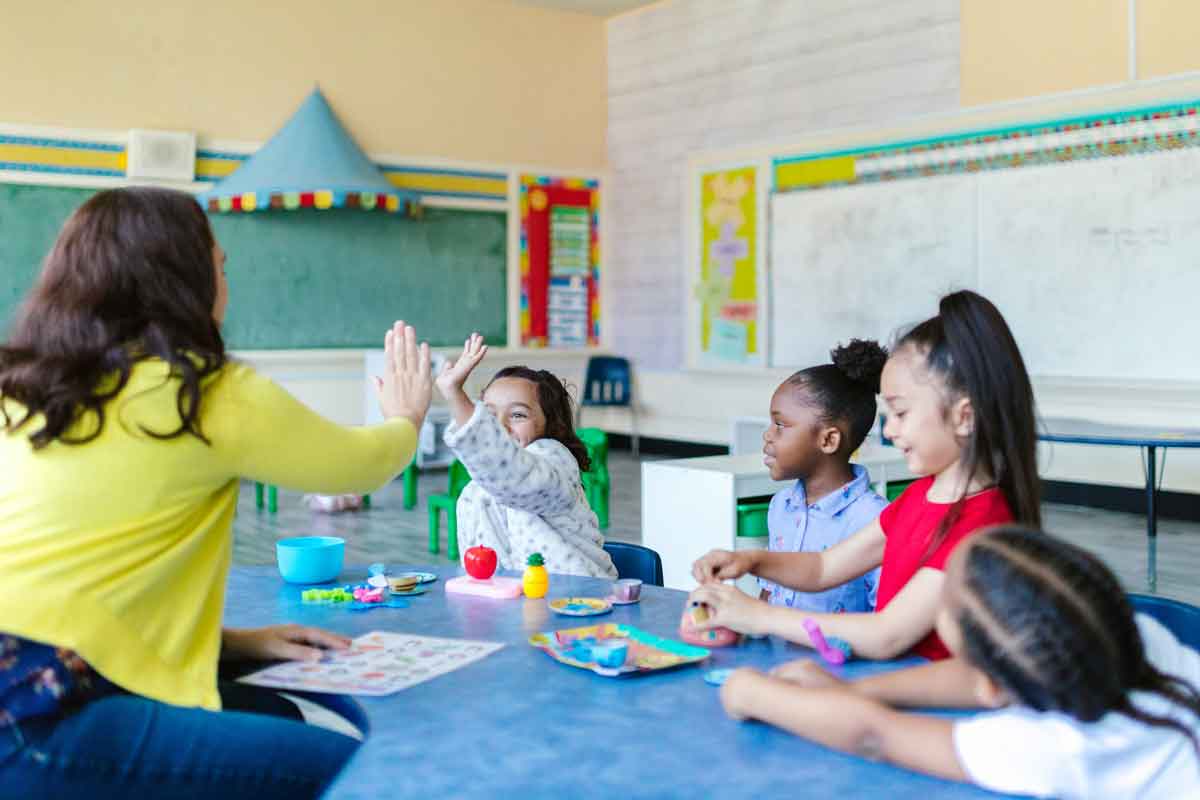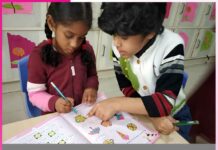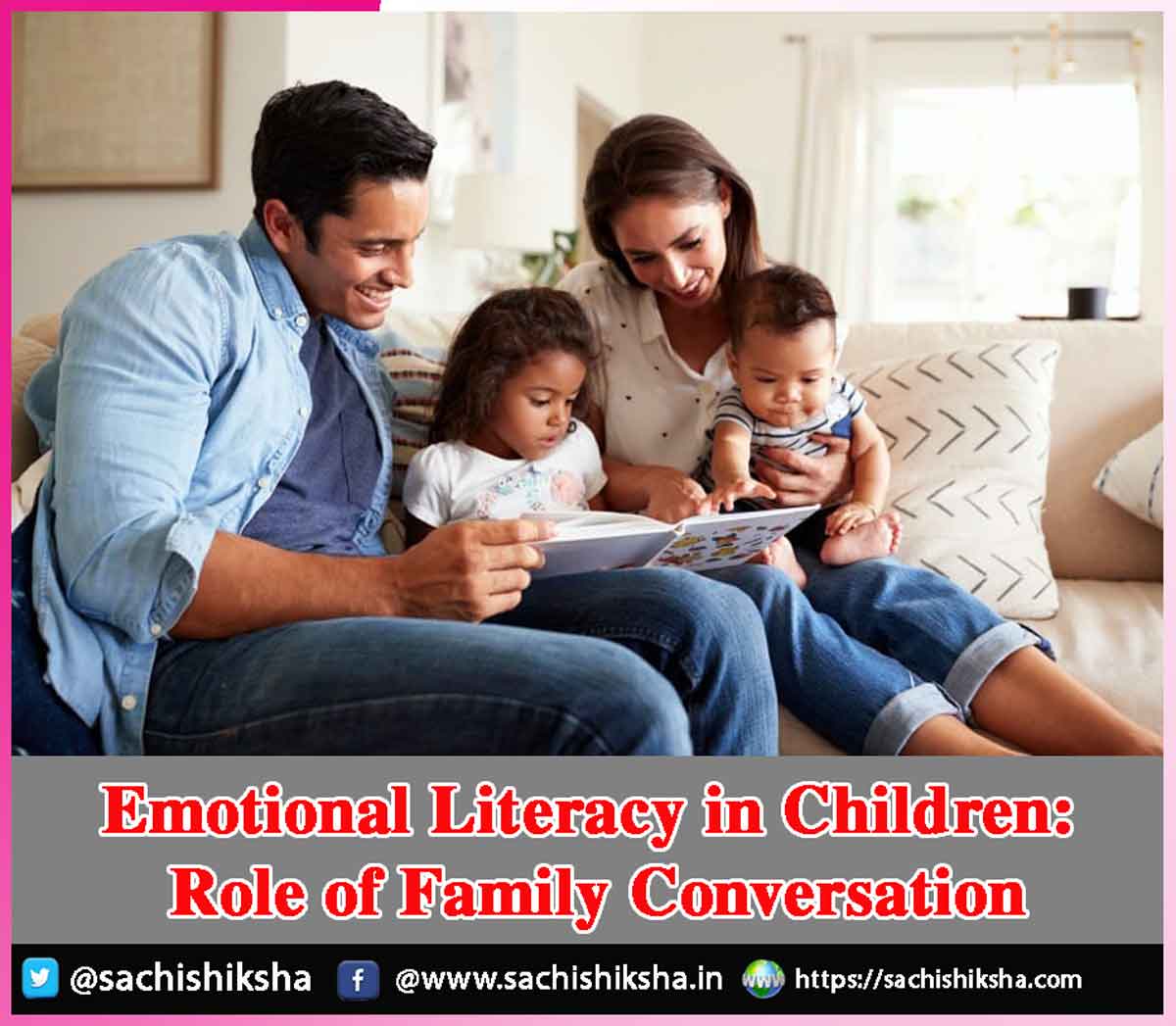Emotional Literacy in Children: Role of Family Conversation
Introduction: Emotional literacy—the skill to recognize, comprehend, communicate, and control emotions—is essential for a child’s overall growth. It directly influences how children navigate their internal experiences, connect with others, solve problems, and adapt to life’s challenges. Emotional literacy is not a trait that emerges naturally; rather, it is learned and nurtured within relational contexts, particularly in the family. Among various family dynamics, family conversation stands out as a powerful tool for fostering emotional literacy.
Table of Contents
The Psychology Behind Emotional Literacy
According to developmental psychology, emotional development is deeply rooted in the interactions a child has with his environment. Vygotsky’s socio cultural theory highlights that learning is a social process, and emotional competencies, like cognitive ones, are constructed through dialogue and interaction with more knowledgeable others—primarily caregivers. Responsive parenting, where caregivers acknowledge and help children make sense of their emotions, fosters both attachment and emotional competence.
Why Emotional Literacy Matters in Childhood

- Academic Achievement: SEL (Social and Emotional Learning) programs that support emotional literacy have been associated with higher academic performance.
- Mental Health and Resilience: Children who can name and express emotions are less likely to internalize stress or act out.
- Long-Term Success : A longitudinal study by the American Psychological Association found that children with strong emotional skills in kindergarten were more likely to graduate from high school, attain stable employment, and avoid legal issues in adulthood.
Family as the First Emotional Classroom
The families are the primary context in which children first encounter and make sense of emotions. From infancy, children observe how their caregivers express, manage, and discuss feelings. These early interactions provide a template for their own emotional behavior. Family conversations, both structured and spontaneous, create opportunities for children to develop emotional literacy in a safe, supportive environment.
Types of Family Conversations that Foster Emotional Literacy
Not all conversations are equal in emotional impact. Some are more developmentally beneficial than others. Key types include:
-
Emotion-Focused Conversations
These are direct discussions about feelings, such as:
“You seem frustrated—do you want to tell me what happened?”
“It’s okay to feel sad. What can we do to feel better?”
Such dialogues help children understand that all emotions are valid and manageable.
-
Reminiscing and Narrative Talk
When families talk about past experiences—especially emotionally charged ones—children gain insight into the nature and consequences of feelings. For example:
“Do you remember your birthday last year? You were so excited!”
This helps develop autobiographical memory, emotional insight, and meaning-making.
-
Modeling Conversations
Parents model emotional intelligence when they express their own emotions constructively. Children observe how adults deal with stress and emotions, and they internalize those strategies.
-
Play-Based Talk
Young children often express themselves best through play. When parents engage in pretend play and storytelling, they can explore emotions in symbolic, less threatening ways.
Strategies to Promote Emotional Literacy
-
Create Emotionally Safe Spaces
Establish home as a judgment-free zone where all emotions are accepted. Avoid shaming or dismissing feelings like:
“Stop crying, it’s not a big deal.”
“You shouldn’t feel that way.”
Instead, say:
“I see that you’re upset. Do you want to talk about it?”
-
Practise Active Listening
Give children your full attention when they speak. Avoid interrupting or rushing to solutions. Instead, validate and reflect:
“That must have been hard. Tell me more.”
-
Encourage Storytelling and Reflection
Share your own stories and ask children to tell theirs. Use pictures, journals, or drawing to help younger children reflect. Discuss past emotional experiences with questions like:
“What were you feeling when that happened?”
“What helped you feel better?”
-
Use Books and Media
Reading emotionally rich books and watching shows with emotional themes offer excellent prompts for conversation. Ask:
“How do you think that character felt?”
“What would you do in that situation?”
Significance of Emotional Literacy
Emotional literacy is essential for thriving in modern society. Its significance spans various dimensions:
-
Mental Health and Well-being
People who are emotionally educated are more capable to deal with pressure, overcome hardship, and preserve their mental health. They are less inclined to employ destructive methods of coping like drug abuse or violence.
-
Academic and Educational Success
In schools, emotional literacy is foundational to learning. Students who understand and manage their emotions are more engaged, resilient, and capable of handling academic challenges. Emotional literacy also supports skills like attention, motivation, and impulse control—all critical for learning.
-
Social and Interpersonal Relationships
Effective communication, empathy, and conflict resolution all hinge on emotional literacy. Whether in friendships, romantic relationships, or professional settings, understanding emotions helps people build trust, navigate conflicts, and respond to others with compassion. A lack of emotional literacy often leads to misunderstandings, resentment, and breakdowns in communication.
-
Workplace and Leadership Effectiveness
In the workplace, emotional literacy enhances collaboration, leadership, and organizational culture. Moreover, emotional literacy helps in managing workplace stress, improving decision-making, and fostering innovation by promoting open, respectful dialogue and emotional resilience.
Challenges to Emotional Literacy
Despite its importance, emotional literacy is not universally nurtured or valued. Several barriers hinder its development:
-
Cultural and Social Norms
In many cultures, expressing emotions—especially vulnerability—is discouraged. Boys, for instance, are often socialized to suppress sadness or fear, leading to emotional repression.
Cultural differences in emotional expression can also lead to misunderstandings or mislabeling of emotions. In some cultures, emotional restraint is a sign of strength; in others, openness is encouraged.
-
Educational Priorities
Traditional education systems prioritize cognitive development and academic achievement over emotional growth. SEL programs are still not universally implemented or funded, despite evidence of their benefits.
-
Technological Disconnection
The rise of digital communication has reduced face-to-face interactions, impacting emotional development. Text-based communication lacks nonverbal cues, which are critical for emotional understanding. Moreover, excessive screen time can reduce opportunities for emotional learning.
-
Mental Health Stigma
In many societies, discussing emotions or mental health is stigmatized. This creates an environment where emotional literacy is neglected or undervalued, particularly in men or certain ethnic groups.
Advantages of Emotional Literacy in Children
-
Improved Social Relationships
Emotional literacy fosters empathy and effective communication, which are vital for building and maintaining healthy relationships with peers and adults.
-
Better Mental Health
Children who can identify and express their emotions are less likely to experience anxiety, depression, and other mental health issues. Emotional literacy contributes to emotional regulation, which is a protective factor against mental health problems, promoting resilience in the face of adversity.
-
Conflict Resolution Skills
They possess the ability to understand different perspectives and manage disagreements without resorting to aggression or withdrawal.
Emotional Literacy and Diversity
A key aspect of emotional literacy is the ability to understand emotions across different cultural, gender, and social contexts. Emotional experiences are influenced by identity, background, and environment.
-
Gender and Emotional Expression
Gender norms often shape how emotions are expressed or perceived. For example, women may be more encouraged to express empathy, while men may be taught to conceal vulnerability. Emotional literacy requires recognizing and challenging such norms to create more emotionally inclusive spaces.
-
Cross-Cultural Understanding
In multicultural societies, emotional literacy involves empathy across cultural lines. This includes understanding culturally specific expressions of emotion and being open to different emotional norms and values.
The Future of Emotional Literacy
As global challenges such as climate change, political polarization, and mental health crises intensify, emotional literacy will become increasingly vital. Here are some future directions:
-
Workplace Transformation
The future workplace will require leaders who are emotionally literate and employees who can collaborate across differences.
-
Global Citizenship and Empathy
In a connected world, emotional literacy supports global cooperation, empathy for distant others, and ethical responsibility. Emotionally literate citizens are better equipped to address global challenges through compassionate action.
Conclusion
Emotional literacy is a vital skill that supports children’s well-being, academic success, relationships, and long-term outcomes. While schools and therapists can help foster emotional skills, the family remains the most influential arena for emotional learning. Among family interactions, conversation—whether through daily talk, storytelling, or emotional coaching—is one of the most powerful and underutilized tools for nurturing emotionally intelligent children.
In a rapidly changing and emotionally demanding world, nurturing emotional literacy from childhood to adulthood is both an individual and collective responsibility. Investing in emotional literacy is investing in humanity’s ability to thrive—not just survive—in the complexity of the 21st century.













































